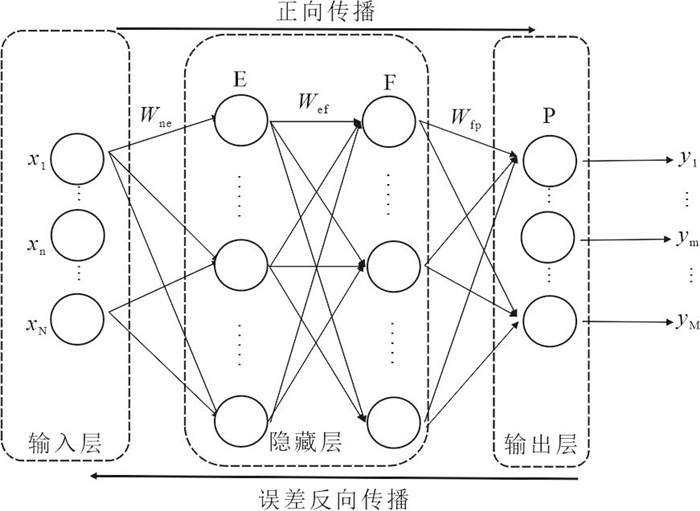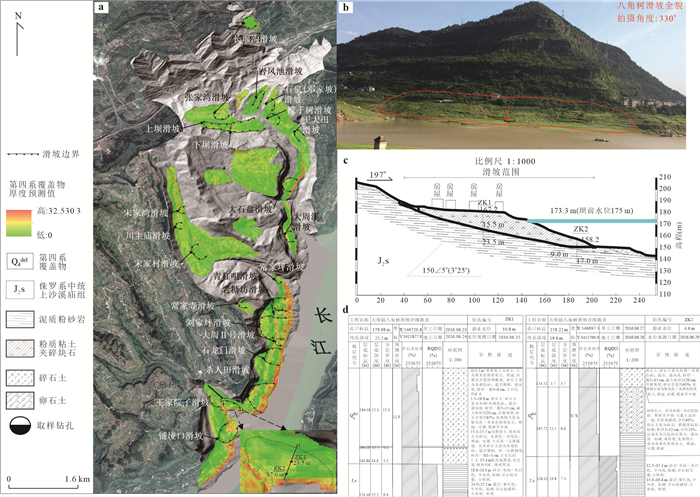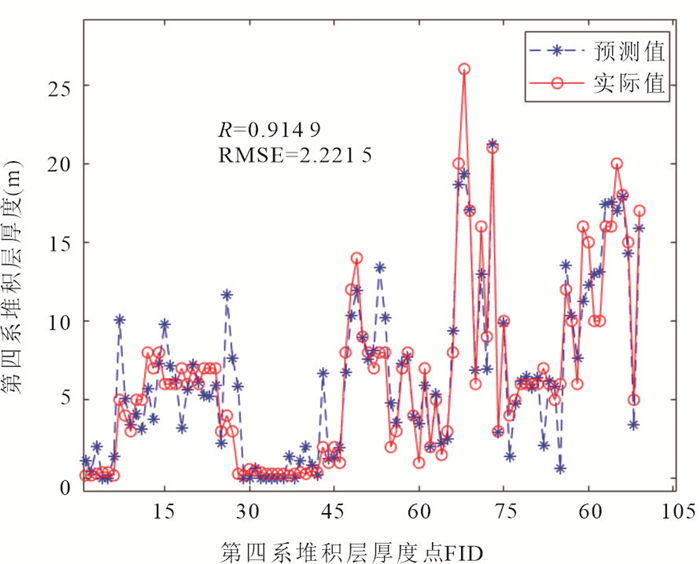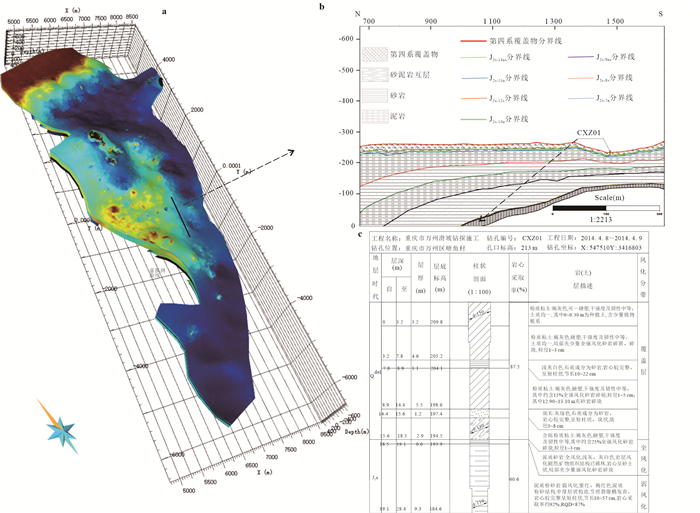Prediction of Quaternary Cover Thickness and 3D Geological Modeling Based on BP Neural Network
-
摘要: 地质灾害风险精细化调查和评估是目前地质灾害减灾防控的重要内容. 斜坡三维地质建模技术的发展为滑坡灾害风险精细化调查评估提供了新的思路,可大幅提高区域范围内滑坡灾害调查的效率和评估精度. 基于Skua-Gocad平台,针对第四系覆盖物和下伏基岩两大模块开展区域斜坡三维地质建模技术研究,以重庆市万州区大周镇为例,采用BP神经网络模型,通过构建研究区第四系覆盖物厚度与地质环境指标的多维非线性网络实现了第四系覆盖物厚度预测. 结合现场调查数据进行方法验证,基于BP神经网络的第四系覆盖物厚度预测精度达91.49%,在此基础上构建了三维地质模型,具有良好的可视化效果,并确保了数据的可靠性. 克服了传统基于克里金插值方法无法反应地质环境因素的缺点,解决了区域范围第四系覆盖物厚度预测的难题.Abstract: Fine investigation and assessment of geological disaster risk is an important part of prevention and control of geological disaster reduction at present. The development of 3D slope geological modeling technology provides a new idea for detailed investigation and assessment of landslide hazard risk, which can greatly improve the efficiency and assessment accuracy of landslide hazard investigation in the region.In this paper, based on Skua-Gocad platform, three-dimensional geological modeling technology of regional slope is studied for two modules of Quaternary cover and underlying bedrock. Taking Dazhou Town, Wanzhou District, Chongqing as an example, BP neural network model is used to predict the thickness of Quaternary cover by building a multi-dimensional nonlinear network of Quaternary cover thickness and geological environment indicators in the study area.Combined with the field survey data, the method is verified, and the prediction accuracy of Quaternary cover thickness based on BP neural network reaches 91.49%. On this basis, a 3D geological model is built, which has good visualization effect and ensures the reliability of data.It overcomes the shortcoming of traditional Kriging interpolation method that can't reflect geological environment factors, and solves the difficult problem of prediction of Quaternary cover thickness in regional scope.
-
0. 引言
地质灾害风险调查和评估是目前地质灾害减灾防控的重要内容. 然而,随着地质灾害风险调查的精细化和评估的定量化,调查评估内容和精度的要求也不断提高,极大增加了专业调查人员的工作强度和难度(张茂省等,2008). 其中,斜坡地质环境指标,尤其是斜坡地质结构、岩土类型与分布的调查对滑坡灾害风险精细化评估至关重要,然而,在野外地质调查过程中,由于工作区范围大,针对斜坡结构开展逐坡调查要求的工作量大(缪信,2016),第四系覆盖物厚度估测困难(Thak et al.,2021). 第四系覆盖物不仅影响自然灾害的破坏强度及概率,也影响斜坡的稳定性,目前已有地质图无法反映区域第四系覆盖物厚度信息,第四系覆盖物厚度和地层结构主要依赖于地质勘查,成本高,难以大范围推广(Clyde and Fisher, 1997;Zhang et al.,2018). 随着地理信息系统(GIS)和计算机图形学技术的发展,三维地质模型成为广泛关注的热点(朱大培等,2001;熊祖强,2007;李明超等,2020;陈莹莹等,2022). 斜坡三维地质建模技术的发展为滑坡灾害风险精细化调查提供了新的思路,开展斜坡三维地质建模技术研究,对大幅提高区域范围内斜坡地质环境调查的效率和滑坡灾害风险评估的精度具有重要的理论和实际应用价值.
自20世纪70年代以来研究学者在三维地质建模技术的开发及应用方面成果显著,例如:Houlding(1992)最早利用三维地质模型开展地下污染物评估;Jiang et al.(2012)基于区域地质资料建立了滑坡三维地质模型,为滑坡的稳定性评价提供了客观的信息支持;Muzik et al.(2015)利用克里金插值法建立滑坡各层面模型,为描述滑坡工程地质环境提供了有力的依据. 目前三维地质建模主要是基于研究区地质勘查钻孔获取的地层信息,利用改进插值算法建立三维地质模型,进而更直观地表达研究区地质环境信息(Che and Jia, 2019). 但是,由于钻孔成本高,如何在区域范围内利用有限钻孔数据建立可靠的三维地质模型依然是技术瓶颈问题(Zhu et al.,2014;Wang et al.,2018).
区域范围斜坡三维地质建模主要可以分为下伏基岩地层结构建模和第四系覆盖物建模两大模块. 针对下伏基岩地层结构的建模主要是依据地质调查和勘查所得地层年代、岩性及产状信息推测地层结构的空间分布,这种方法尤其在地质构造简单的地区应用良好(Wen,2018). 而相比于下伏基岩地层结构构建而言,针对第四系覆盖物的构建相对困难,这主要是因为第四系覆盖物厚度受地质环境条件的影响更大,其分布的不确定性更强(Cascini et al.,2016). 第四系覆盖物厚度预测多采用调查、钻探和物探等地质调查和勘查手段获得样本,进而利用插值计算方法获得区域上第四系堆积层厚度分布. 例如:易湘生等(2012)采用确定性内插及地统计内插两类插值法预测了第四系堆积层厚度,结果表明这两类方法均有其合理性. 但是,由于传统插值法将地质环境标志平均化,无法反映地质环境变化与第四系覆盖物厚度变化的相关性,预测结果受样本点数量和位置的影响巨大,预测精度亟待提高(杜文凤和彭苏萍,2010;Wang et al.,2018).
伴随人工智能的发展,机器学习在多维非线性拟合方面表现出显著优势(Yang and Song, 2009;Na et al.,2013;Yip et al.,2016). 机器学习方法也因其可以避免地质环境标志平均化的问题而被应用于第四系覆盖物厚度预测(Kuriakose et al.,2009). 在研究过程中引入了高程、坡度等多变量,结果表明第四系覆盖物厚度与地形地貌类型呈现显著的相关性. 刘磊等(2016)选取坡度、曲率等与第四系堆积层厚度相关的指标,采用随机森林的方法对研究区第四系覆盖物厚度进行预测,获得了较高的预测精度. 但是以上研究多考虑地形指标,没有考虑下伏基岩类型对第四系覆盖物厚度的影响,第四系覆盖物厚度预测评价指标体系仍需完善.
本文以重庆市万州区大周镇为例,基于实地调查现场调查获取第四系覆盖物厚度样本数据,通过采用BP(back propagation)神经网络模型构建研究区第四系覆盖物厚度与地质环境因子间的关联关系,预测了研究区第四系覆盖物厚度,基于实例论证预测模型的可靠性,解决了第四系覆盖物厚度难以通过实地调查和勘查获取的难题. 同时,为反映研究区第四系覆盖物厚度变化及下伏基岩变化趋势,本文基于钻孔数据的三维构造模型,构建了研究区斜坡三维地质模型,实现了研究区域的三维地质可视化,为滑坡灾害风险精细化评估提供可靠的数据支持.
1. 研究方法
1.1 基于BP神经网络的第四系覆盖物厚度预测方法
BP神经网络最早于1986年由David Runelhart及Geoffrey Hinton等人提出,是目前应用最为广泛的神经网络之一(Yan,2015). BP神经网络的基本思想是:学习过程由正向传播和误差反向传播组成. 正向传播时,样本经过隐藏层处理后到达输出层,若输出层结果与期望输出不一致则进入误差反向传播阶段. 误差反向传播时,输出层将误差通过隐藏层反向传播至输入层,并将误差分摊至所有神经元,此误差作为修正各单元的依据. 通过不断进行该类传播来逐步调整各层权重,这个过程即神经网络的训练过程. 神经网络的训练直至达到人为设置的训练次数或网络可接受的程度为止,得到经过样本训练的BP神经网络. 图 1为两层隐藏层的BP神经网络结构图.
以两层隐藏层BP神经网络为例,输入层有N个神经元,第一层隐藏层为E,表示该隐藏层有E个神经元,任一神经元为e;第二层隐藏层为F,表示该隐藏层有f个神经元,任一神经元为f,输出层为P,表示有P个输出,任一输出为p. 输入层神经元n与第一层隐藏层神经元e的连接权重为$ {w}_{ne} $,第一层隐藏层神经元e与第二层隐藏层神经元f的连接权重为$ {w}_{ef} $,第二层隐藏层神经元f与输出层神经元p的连接权重为$ {w}_{fp} $.
(1)在正向传播过程中,在神经元n的激活函数f处的输入$ {v}_{e} $为:
(1) 则出现在神经元n输出处的函数信号$ {u}_{e} $为:
(2) 在隐藏层E的神经元e激活函数f处的输入$ {v}_{f} $为:
(3) 则出现在神经元e输出处的函数信号$ {u}_{f} $为:
(4) 于是输出层神经元p输出处的函数信号$ {y}_{p} $为:
(5) (2)由于神经网络已收到一次正向传播信号,因此存在实际输出$ {y}_{p} $及期望输出$ {d}_{p} $,则神经元p的输出产生误差可表示为$ {i}_{p} $,表达为:
(6) 则在神经网络上的总均方误差$ I $:
(7) BP算法基于梯度下降策略,对于误差$ \mathrm{E} $,给定学习率η则有权重修正值Δ$ {w}_{fp} $表达为
(8) 类似可得:
(9) 采用BP神经网络预测第四系覆盖物厚度主要包括以下流程:(1)选取与第四系覆盖物厚度相关的沉积及地形地貌指标;(2)基于实地勘测、调查等方法,获取用于训练神经网络的已知第四系覆盖物厚度点样本数据;(3)训练用于预测第四系覆盖物厚度的神经网络模型,并利用拟合精度R及均方根误差RMSE评价模型精度;(4)将待预测区域的沉积及地形地貌指标输入已训练完成的神经网络,得到输出层为第四系覆盖物厚度预测值.
1.2 三维地质建模方法
三维构造模型以钻孔数据为基础,用于分析各地层厚度变化趋势,三维构造模型精细程度较高并可以切割出模型内的任一剖面,从而. 利用三维构造模型法建立三维地质模型主要包括以下流程:(1)标定研究区钻孔位置;(2)根据地层年代及岩性类别,标定研究区各钻孔地层层序、层厚和岩组分类,如地层岩组厚度及每段地层岩组代号;(3)根据研究区范围,约束区域边界;(4)构造模型,得到研究区三维地质模型.
获取用于三维地质建模的钻孔信息往往面临实地钻孔成本高、钻孔空间分布不均匀、钻孔信息难以以点概面等问题. 此外,目标建模区域内钻孔数量较少、钻孔在空间上分布不均匀,都会造成三维地质建模精度降低(申健等,2008;王瑶等,2017),因此需要辅以虚拟钻孔补充目标模型区域地质信息提高模型精度. 虚拟钻孔应布置于控制目标区域地层信息的位置以采集有效的地层信息. 为反应研究区各地层厚度趋势,虚拟钻孔应包含第四系覆盖物厚度和下伏基岩厚度两方面信息. 结合上文1.1中第四系覆盖层厚度预测成果,提取第四系平面内覆盖物厚度信息,根据确定的地质勘察信息建立虚拟钻孔,提高三维地质模型精度. 神经网络预测第四系覆盖物厚度结合三维地质建模的具体流程如图 2所示.
2. 研究区概况及地质建模
2.1 研究区工程地质概况
研究区为重庆市万州区大周镇,如图 3所示,位于万州向斜北西翼,岩层呈单斜产出,岩层产状:倾向160°∠(5°~30°). 研究区老-新出露地层自西北向东南展布,自侏罗系上统遂宁组(J3S)至侏罗系上沙溪庙组(J2S)均有出露. 根据实地调查显示,第四系覆盖物主要分布在长江岸边、河谷阶地及区域长斜坡中下部,主要包括河流冲积、残破积和崩坡积等. 侏罗系上统遂宁组分布临近长江,沿岸边分布,主要由紫红色细粒石英砂岩夹砖红色、紫红色泥岩组成. 侏罗系中统上沙溪庙组分布于大周镇中部、北部及南部,主要由紫红色泥岩夹灰紫色长石石英砂岩及粉砂岩. 研究区属亚热带季风湿润气候,降雨多集中于5—9月,长江自南西向北东流经整个研究区,除干流外还发育有大周溪支流. 大周镇共发育地质灾害44处,滑坡和崩塌是该地区的主要灾害类型,其中滑坡灾害共发育38处,崩塌灾害共发育6处.
2.2 地层视厚度获取
基于BP神经网络预测模型,获取第四系覆盖物厚度,为建立区域内虚拟钻孔数据库,同时结合地层视厚度. 选取两条能够控制大周镇地层分布的剖面线进行实地调查,将大周镇工程地质岩组分为三大类:泥岩、砂岩和砂泥岩互层,并在此基础上对侏罗系中统上沙溪庙组细分为14段,厚度约860~960 m,侏罗系上统遂宁组共分为2段,厚度约280~380 m. 根据实地调查及实测结果,绘制大周镇工程地质剖面图,从该区域地层剖面图获取重庆市万州区大周镇岩层视厚度.
2.3 第四系覆盖物厚度预测
根据研究区工程地质概况,选取与第四系堆积层厚度相关的控制性沉积及地形地貌因素有:植被覆盖度、高程、坡度、坡向、平面曲率、剖面曲率、地形湿度、第四系覆盖物类型、软硬岩性.
表 1 沉积及地形地貌指标及选取原因Table Supplementary Table Deposit and topographic indicators and selection reasons地形地貌因素 选取原因 归一化植被指数 第四系覆盖物对植被演化具有关键作用,植被覆盖也反映地区第四系覆盖物厚度(柴强, 2015) 高程 与第四系覆盖物厚度具有显著相关性,根据高程不同具有垂直分布特点(Penížek and Borůvka, 2006) 坡度 Ziadat et al.(2010)从DEM栅格图层中提取地形指标预测土壤厚度,利用实地测量的土壤厚度数据与预测数值做对比,结果显示土壤厚度与坡度及坡向指标呈显著的正相关 坡向 平面曲率 Patton et al.(2018)建立第四系覆盖物厚度-曲率关系模型,结果表示两者具有相关度的线性关系 剖面曲率 地形湿度 第四系覆盖物厚度易受流水搬运及库岸堆积影响,地形湿度直接影响覆盖物运移(Mehnatkesh et al., 2013) 第四系覆盖物类型 风化、崩落方式而形成的残积、崩积物影响第四系覆盖物厚度 软硬岩性 第四系覆盖物的下伏基岩软硬程度为第四系覆盖物急供聚集基础(孙立群等, 2021) 各地貌因素中,高程、坡度、坡向、平面曲率、剖面曲率、地形湿度指标通过DEM栅格单元提取,利用Landsat8卫星数据计算研究区归一化植被指数,研究区第四系覆盖物类型和软硬岩性由实地调查获取. 为建立适用于第四系覆盖物厚度预测的神经网络,将实测第四系覆盖物样本点与沉积及地形地貌指标连接,共形成99组用于训练神经网络的样本点,样本点数据分布如图 3c所示,样本点数据中,70%样本用于训练神经网络,10%用于验证神经网络模型,20%用于测试训练后的网络.
研究区采用像元大小为5 m×5 m的DEM栅格数据,栅格共划分866列、2 429行,并基于GIS提取研究区内9类沉积及地形地貌指标的点数据,共获得275 696组多维变量,沉积及地形地貌指标如图 4所示.
经过研究区样本点神经网络训练得到各点第四系覆盖物厚度预测值,进而基于GIS平台获得平面上第四系覆盖物厚度分布图,结果如图 5.
从图 5a可知,颜色偏红的区域为第四系覆盖物较厚的区域,由于沉积和有机物堆积等作用,使第四系覆盖物逐渐加厚,对应在图中为长江岸边,呈带状分布,颜色偏绿的区域为第四系覆盖物较薄的区域,对应分布于堆积作用不明显的坡度较陡及陡崖地带,以上地区第四系覆盖物厚度分布与实际成因规律相一致.
大周镇所处地质环境下,发育有多处滑坡灾害,多为堆积层滑坡,典型特点为具有较厚层第四系覆盖物,为滑坡发生提供物质来源,在降雨条件下易沿岩土界面产生滑坡变形. 八角树滑坡为大周镇一典型历史滑坡灾害,进行了多次包括钻探的详细勘察,自三峡水库蓄水,滑坡开始出现变形,滑坡中后部房屋已受滑坡严重破坏无法使用,库区退水后,滑坡前缘出现不同程度垮塌. 从八角树滑坡工程地质剖面图图 5c中不难看出,相比前缘及后缘,第四系覆盖物多集中于八角树滑坡中部(陈松等,2008),与图 5a中八角树滑坡所在区域的第四系覆盖物厚度分布相符,在其滑体土长期重力作用下,滑坡表面第四系覆盖物逐渐向前缘聚集,在库区蓄水后堆积于水位线前,库区退水后,部分覆盖物向前方垮塌.
综上,第四系覆盖物厚度预测平面分布在宏观上与大周镇地形地貌较一致,与区域内历史滑坡灾害上第四系覆盖物相比,符合其演化规律.
2.4 预测精度分析
通过对预测值样本实际值、实际勘察值进行对比分析比较,结果表明,由BP神经网络模型预测的第四系堆积层厚度与样本点厚度值呈现显著的相关性,拟合优度R=0.914 9,表明BP神经网络预测模型具有较为理想的学习能力. 通过训练样本的实测99组第四系覆盖物厚度数据与预测值对比,计算得到均方根误差RMSE=2.221 5,如图 6.
继而提取实地钻孔位置的第四系覆盖物厚度预测数值,与实际钻探所获取的第四系覆盖物厚度作对比(图 5d),结果见表 2.
表 2 第四系覆盖物厚度预测值与实测值对比Table Supplementary Table Comparison between predicted and measured valuesof Quaternary covering thickness钻孔编号 实测值(m) 预测值(m) 绝对误差(m) 相对误差 ZK1 18.8 12.90 5.90 31.38% ZK2 12.5 8.78 3.72 29.76% 由表 2可得,基于BP神经网络的大周镇第四系覆盖物厚度预测值与实测值的绝对误差在3.72~5.90 m之间,分析其误差原因,由于选择的八角树滑坡位于长江边,其第四系覆盖物厚度受库水位涨落影响较大,因此产生误差,但由图 6可看出,第四系覆盖物厚度预测值与真实值总体误差较小,具有较高可信度.
为建立虚拟钻孔信息,依据研究区岩层分段,基于大周镇已有两条剖面构造垂直于剖面线方向具有一定间距的平行线,将剖面线及平行线作为区域三维地质建模的基准线,在基准线上确定共150处虚拟钻孔. 为获取虚拟钻孔点地层信息,基于预测得出的第四系堆积层厚度栅格,将第四系堆积层厚度信息赋予虚拟钻孔,根据重庆市万州区大周镇已有工程地质剖面图信息将岩层视厚度信息赋予虚拟钻孔,由已有虚拟钻孔,进一步采用钻孔数据建模法建立重庆市万州区大周镇三维地质模型.
为验证建立的三维地质模型准确度,采用GOCAD软件中切割剖面功能,提取虚拟工程地质剖面图,剖面图中包括万州区大周镇的地层与第四系覆盖物层面,将位于该剖面线的一处钻孔点与虚拟地质剖面图中对应位置作为对比,从图中可看出,第四系覆盖物与浅层下伏基岩厚度较相符,如图 7所示.
3. 结论
(1)通过确定与第四系覆盖物厚度相关性较高的指标因子,利用BP神经网络建立其与覆盖物厚度的关系,结果表明训练的网络具有较高的拟合精度. 在大周镇第四系覆盖物范围内提取预测所需指标,代入已训练神经网络中预测得到对应的第四系覆盖物厚度值,结果表明:对于多维非线性拟合,BP神经网络具有良好的学习效果,适用于第四系覆盖物范围的厚度预测,避免了插值法忽略地形地貌信息的问题,与实际地形地貌造成的第四系堆积结果相符,解决了第四系覆盖物厚度难以获取的问题,有利于精细化滑坡风险评价. 但是,指标选取存在进一步优化的问题,由于第四系覆盖物厚度由多种因素控制,不仅包括沉积及地形地貌,人类工程活动同样影响第四系覆盖物的搬运,因此选取更多相关指标可以反应实际地区的第四系覆盖物厚度分布.
(2)BP神经网络预测模型结果结合野外勘察数据,生成虚拟钻孔作为补充钻孔数据,利用GOCAD软件建立基于三维钻孔点的三维地质模型. 三维地质模型显示,通过补充虚拟钻孔点建立出的模型具有可靠性,可视化方法适用于三维地质模型的构建.
(3)基于样本数据训练得到用于预测区域第四系覆盖物厚度的模型,对于实际勘察工作起到补充调查的作用,基于三维地质建模技术,建立区域三维地质模型,可以更直观反映区域起伏变化,通过补充的下伏基岩层面,为区域地质构造提供直观可视化模型.
-
表 1 沉积及地形地貌指标及选取原因
Table 1. Deposit and topographic indicators and selection reasons
地形地貌因素 选取原因 归一化植被指数 第四系覆盖物对植被演化具有关键作用,植被覆盖也反映地区第四系覆盖物厚度(柴强, 2015) 高程 与第四系覆盖物厚度具有显著相关性,根据高程不同具有垂直分布特点(Penížek and Borůvka, 2006) 坡度 Ziadat et al.(2010)从DEM栅格图层中提取地形指标预测土壤厚度,利用实地测量的土壤厚度数据与预测数值做对比,结果显示土壤厚度与坡度及坡向指标呈显著的正相关 坡向 平面曲率 Patton et al.(2018)建立第四系覆盖物厚度-曲率关系模型,结果表示两者具有相关度的线性关系 剖面曲率 地形湿度 第四系覆盖物厚度易受流水搬运及库岸堆积影响,地形湿度直接影响覆盖物运移(Mehnatkesh et al., 2013) 第四系覆盖物类型 风化、崩落方式而形成的残积、崩积物影响第四系覆盖物厚度 软硬岩性 第四系覆盖物的下伏基岩软硬程度为第四系覆盖物急供聚集基础(孙立群等, 2021) 表 2 第四系覆盖物厚度预测值与实测值对比
Table 2. Comparison between predicted and measured valuesof Quaternary covering thickness
钻孔编号 实测值(m) 预测值(m) 绝对误差(m) 相对误差 ZK1 18.8 12.90 5.90 31.38% ZK2 12.5 8.78 3.72 29.76% -
Cascini, L., Ciurleo, M., Di Nocera, S., 2016. Soil Depth Reconstruction for the Assessment of the Susceptibility to Shallow Landslides in Fine-Grained Slopes. Landslides, 14(2): 459-471. https://doi.org/10.1007/s10346-016-0720-8 Chai, Q., 2015. The Analysis about Soil Main Properties and Its Influence Factors of Grassland in Xinjiang(Dissertation). Xinjiang Agricultural University, Xinjian(in Chinese with English abstract). Che, D. F., Jia, Q. R., 2019. Three-Dimensional Geological Modeling of Coal Seams Using Weighted Kriging Method and Multi-Source Data. IEEE Access, 7: 118037-118045. https://doi.org/10.1109/access.2019.2936811 Chen, S., Chen, G. J., Xu, G. L., 2008. Mechanism of Geological Processes of Formation and Deformation of the Huangtupo Landslide. Earth Science, 33(3): 411-415(in Chinese with English abstract). doi: 10.3321/j.issn:1000-2383.2008.03.017 Chen, Y. Y., Li, Y. Q., Wei, D. T., et al., 2021. Quantitative Relationship between Tectonic Deformation and Topography in Bogda Piedmont of Eastern Tianshan Mountains: Based on 3D Structural Modeling and Geomorphic Analysis. Earth Science, 47(2): 418-436(in Chinese with English abstract). Clyde, W. C., Fisher, D. C., 1997. Comparing the Fit of Stratigraphic and Morphologic Data in Phylogenetic Analysis. Paleobiology, 23(1): 1-19. https://doi.org/10.1017/s0094837300016614 Houlding, S. W., 1992. Subsurface Contaminant Assessment by 3D Geoscience Modeling. In: Singhal, R. K., Mehrotra, A. K., Fytas, K., eds., Environmental Issues and Management of Waste in Energy and Mineral, AA Balkema, Calgary, Canada, 1355-1362. Jiang, T. Y., Cui, L. L., Li, J. H., 2012. An Implementation of 3D Landslide Geological Modeling and Visualization. Advanced Materials Research, 594-597: 2338-2343. https://doi.org/10.4028/www.scientific.net/amr.594-597.2338 Kuriakose, S. L., Devkota, S., Rossiter, D. G., et al., 2009. Prediction of Soil Depth Using Environmental Variables in an Anthropogenic Landscape, a Case Study in the Western Ghats of Kerala, India. CATENA, 79(1): 27-38. https://doi.org/10.1016/j.catena.2009.05.005 Li, M. C., Bai, S., Kong, R., et al., 2020. 3D Parametric Modeling Method of Engineering-Scale Geological Structures. Chinese Journal of Rock Mechanics and Engineering, 39(Supp. 1): 2848-2858(in Chinese with English abstract). Liu, L., Yin, K. L., Zhang, J., 2016. Estimation Method of the Quaternary Deposits Thickness and Its Application in Wanzhou Central District, Three Gorges Reservoir Region. Bulletin of Geological Science and Technology, 35(1): 177-183(in Chinese with English abstract). Mehnatkesh, A., Ayoubi, S., Jalalian, A., et al., 2013. Relationships between Soil Depth and Terrain Attributes in a Semi Arid Hilly Region in Western Iran. JournalofMountainScience, 10(1): 163-172. https://doi.org/10.1007/s11629-013-2427-9 Miu, X., 2016, Research on Landslide Risk Assessment Considering the States of Slope Activity: A Case of Fengjie New County(Dissertation), Chengdu University of Technology, Chengdu(in Chinese with English abstract). Muzik, J., Vondráčková, T., Sitányiová, D., et al., 2015. Creation of 3D Geological Models Using Interpolation Methods for Numerical Modelling. Procedia Earth and Planetary Science, 15: 25-30. https://doi.org/10.1016/j.proeps.2015.08.007 Na, W. B., Su, Z. W., Zhang, P., 2013. Research of Oilfield Production Forecast Based on Least Squares Fitting and Improved BP Neural Network. Applied Mechanics and Materials, 333-335: 1456-1460. https://doi.org/10.4028/www.scientific.net/amm.333-335.1456 Patton, N. R., Lohse, K. A., Godsey, S. E., et al., 2018. Predicting Soil Thickness on Soil Mantled Hillslopes. Nature Communications, 9(1). https://doi.org/10.1038/s41467-018-05743-y Penížek, V., Borůvka, L., 2006. Soil Depth Prediction Supported by Primary Terrain Attributes: A Comparison of Methods. Plant, SoilandEnvironment, 52(9): 424-430. https://doi.org/10.17221/3461-pse Shen, J., Xu, D. W., Cai, J, X., 2008. 3D Geological Modeling of Landslides Based on Borehole Data. Journal of East China University of Technology(Natural Science), 31(2): 127-130(in Chinese with English abstract). Thak, J. H., Ryu, T. G., Sin, J. S., et al., 2021. Digital Terrain Analysis Approach to Improve Soil Depth Prediction with Parent Material Dataset. Eurasian Soil Science, 54(12): 1818-1825. https://doi.org/10.1134/s1064229321120139 Wang, J. M., Zhao, H., Bi, L., et al., 2018. Implicit 3D Modeling of Ore Body from Geological Boreholes Data Using Hermite Radial Basis Functions. Minerals, 8(10): 443. https://doi.org/10.3390/min8100443 Wang, Y., Zhang, X. Y., Chen, W. J., et al., 2017. Application of Virtual Boreholes in 3D Deep Geological Modeling. Urban Geology, 12(2): 118-122(in Chinese with English abstract). Wen, C. M., 2018. 3D Geological Modeling Technology And Tts Application Tn a Mine. In: 3rd International Conference on Smart City and Systems Engineering(ICSCSE), IEEE, China, 809-812. Xiong, Z. Q., 2007. Study on the Technology of 3D Engineering Geological Modeling and Visualization(PhD thesis). The Chinese Academy of Sciences(Institute of Rock & Soil Mechanics), Wuhan(in Chinese with English abstract). Yan, Z., 2015. Research and Application on BP Neural Network Algorithm. In: International Industrial Informatics and Computer Engineering Conference in Peoples R China 2015, Xi'an, 1444-1447. Yang, L., Song, M. L., 2009. Research on BP Neural Network for Nonlinear Economic Modeling and Its Realization Based on Matlab. In: Luo, Q., Song, M., eds., 3rd International Symposium on Intelligent Information Technology Application, IEEE, Nanchang, 505. Yi, X. S., Li, G. S., Yin, Y. Y., et al., 2012. Comparison on Soil Depth Prediction among Different Spatial Interpolation Methods: A Case study in the Three-River Headwaters Region of Qinghai Province. Geographical Research, 31(10): 1793-1805(in Chinese with English abstract). Yip, H. J., Ji, G. R., Liu, J. H., et al., 2016. Optimal Structure and Parameters of BP Neural Network for Curve Fitting Problem. In: Jing, W., Guiran, C., Huiyu, Z., eds., 6th International Conference on Electronic, Mechanical, Information and Management Society (EMIM), Shenyang, 40: 1647-1652. Zhang, L. Q., Zhang, X., Liang, X., et al., 2021. Identification and Characteristics of the Sedimentary Environment since the Quaternary in Zi River Delta, Dongting Basin. Earth Science, 46(9): 3245-3257(in Chinese with English abstract). Zhang, M. S., Tang, Y. M., 2008. Risk Investigation Method and Practice of Geohazards. Geological Bulletin of China, 27(8): 1205-1216(in Chinese with English abstract). doi: 10.3969/j.issn.1671-2552.2008.08.017 Zhang, W. T., Hu, G. Q., Sheng, J. D., et al., 2018. Estimating Effective Soil Depth at Regional Scales: Legacy Maps versus Environmental Covariates. Journal of Plant Nutrition and Soil Science, 181(2): 167-176. https://doi.org/10.1002/jpln.201700081 Zhu, D. P., Niu, W. J., Yang, Q., et al., 2001. 3 Dimension visualization for Geology-Constructed-Model. Journal of Beijing University of Aeronautics and Astronautics, 27(4): 448-451(in Chinese with English abstract). doi: 10.3969/j.issn.1001-5965.2001.04.018 Zhu, L. F., Wang, X. F., Zhang, B., 2014. Modeling and Visualizing Borehole Information on Virtual Globes Using KML. Computers & Geosciences, 62(1): 62-70. https://doi.org/10.1016/j.cageo.2013.09.016 Ziadat, F. M., 2010. Prediction of Soil Depth from Digital Terrain Data by Integrating Statistical and Visual Approaches. Pedosphere, 20(3): 361-367. https://doi.org/10.1016/s1002-0160(10)60025-2 柴强, 2015. 新疆草地土壤主要性质及影响因素的分析(硕士学位论文). 新疆: 新疆农业大学. 陈松, 陈国金, 徐光黎, 2008. 黄土坡滑坡形成与变形的地质过程机制. 地球科学, 33(3): 411-415. doi: 10.3321/j.issn:1000-2383.2008.03.017 陈莹莹, 李一泉, 魏东涛, 等, 2022. 东天山博格达山前构造变形与地形定量关系: 基于三维建模与地貌分析. 地球科学, 47(2): 418-436. doi: 10.3799/dqkx.2021.097 杜文凤, 彭苏萍, 2010. 利用地质统计学预测煤层厚度. 岩石力学与工程学报, 29(增1): 2762-2767. https://www.cnki.com.cn/Article/CJFDTOTAL-YSLX2010S1028.htm 李明超, 白硕, 孔锐, 等, 2020. 工程尺度地质结构三维参数化建模方法. 岩石力学与工程学报, 39(增1): 2848-2858. https://www.cnki.com.cn/Article/CJFDTOTAL-YSLX2020S1026.htm 刘磊, 殷坤龙, 张俊, 2016. 三峡库区万州主城区第四系堆积层厚度的估算方法及应用. 地质科技情报, 35(1): 177-183. https://www.cnki.com.cn/Article/CJFDTOTAL-DZKQ201601028.htm 缪信, 2016. 考虑斜坡活动性状态的滑坡风险评价技术研究——以奉节新城区为例(硕士学位论文). 成都: 成都理工大学. 申健, 徐大伟, 蔡雄翔, 2008. 基于钻孔数据的滑坡三维地质建模研究. 东华理工大学学报(自然科学版), 31(2): 127-130. https://www.cnki.com.cn/Article/CJFDTOTAL-HDDZ200802006.htm 孙立群, 张鑫, 梁杏, 等, 2021. 洞庭盆地资水三角洲地区第四纪沉积环境判别及其特征. 地球科学, 46(9): 3245-3257. doi: 10.3799/dqkx.2020.357 王瑶, 张像源, 陈文杰, 等, 2017. 虚拟钻孔在深层三维地质建模中的应用. 城市地质, 12(2): 118-122. https://www.cnki.com.cn/Article/CJFDTOTAL-CSDZ201702027.htm 熊祖强, 2007. 工程地质三维建模及可视化技术研究(博士学位论文). 武汉: 中国科学院研究生院(武汉岩土力学研究所). 易湘生, 李国胜, 尹衍雨, 等, 2012. 土壤厚度的空间插值方法比较——以青海三江源地区为例. 地理研究, 31(10): 1793-1805. https://www.cnki.com.cn/Article/CJFDTOTAL-DLYJ201210006.htm 张茂省, 唐亚明, 2008. 地质灾害风险调查的方法与实践. 地质通报, 27(8): 1205-1216. https://www.cnki.com.cn/Article/CJFDTOTAL-ZQYD200808021.htm 朱大培, 牛文杰, 杨钦, 等, 2001. 地质构造的三维可视化. 北京航空航天大学学报, 27(4): 448-451. https://www.cnki.com.cn/Article/CJFDTOTAL-BJHK200104017.htm 期刊类型引用(3)
1. 张村,贾胜,华埜,宋启. 矿山三维地质建模研究进展:原理、方法与应用. 煤炭科学技术. 2025(02): 222-238 .  百度学术
百度学术2. 金辉,高伟,林亮世,杨耿杰. 基于网格指纹匹配的光伏阵列电弧故障定位方法. 高电压技术. 2024(02): 805-815 .  百度学术
百度学术3. 韩世礼,肖健,柳位. 机器学习在地球物理勘探中铀矿资源勘查的应用研究进展. 铀矿地质. 2024(03): 555-564 .  百度学术
百度学术其他类型引用(1)
-











 下载:
下载:







 下载:
下载:






 百度学术
百度学术







